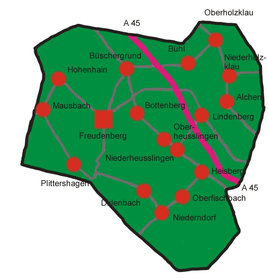Oberheuslingen
|
Oberheuslingen
City of Freudenberg (Siegerland)
Coordinates: 50 ° 53 ′ 34 ″ N , 7 ° 54 ′ 20 ″ E
|
|
|---|---|
| Height : | 303 m |
| Area : | 2.11 km² |
| Residents : | 898 (Jun. 30, 2017) |
| Population density : | 426 inhabitants / km² |
| Incorporation : | 1st January 1969 |
| Postal code : | 57258 |
| Area code : | 02734 |
|
Location of Oberheuslingen in Freudenberg
|
|
Oberheuslingen is a district of Freudenberg in North Rhine-Westphalia .
geography
Oberheuslingen is one of 17 districts of Freudenberg and is located in a heavily forested low mountain range . In the east it borders on the Lindenberg district, in the north on the Bottenberg district and in the south on the Niederheuslingen district.
history
Oberheuslingen consists of several small settlements that are almost completely surrounded by forest, these are Grund , Bruch and Zeitenbach , which have been summarized by name as Grund . The place is mentioned for the first time in 1404 as Huselingen , the parish Grund in 1575 as Obernhönnslingen . The place belonged to the possessions of the Counts of Nassau and in 1557 was transferred to the princely family of Crottorf and Hatzfeld. In 1600 the population was about 43 taxpayers, spread over all parts of the village. According to the landscape, most of the residents built their houses in the lowlands of the Häuslingtal, through which the Heusling and Zeitenbach brooks flow and thus a constant water supply was guaranteed. As a source of income, most of the residents ran agriculture and forestry, especially in the form of the Hauberg . The fields were created on the surrounding higher areas that are around the village. The meadows that were used to feed the cattle, which also needed a large amount of water, were created in the lowlands.
In the years 1630 to 1632 the plague raged in the neighboring communities. In the period from October 1631 to February 1632, 48 residents were killed in Niederndorf. Then the epidemic was over, but reappeared in the village of Niederschelden in 1633. The death bells rang for months and the place had to mourn 65 deaths. In June 1635 the plague broke out in Oberheuslingen and killed 32 people. The plague stopped after two young men got up and took the corpses to Oberfischbach on foot.
Two families worked as charcoal burners and produced charcoal for the "old hut" in the village of Gosenbach, which they delivered by horse and cart. Around 1860 it was found that there were iron ore deposits in Oberheuslingen, after which a mining union was founded and the Morgenstern and Landenberg tunnels were dug. The operation of the tunnels was discontinued after a short time because the desired success did not occur. The location of the tunnels and some of the entrances can still be viewed today.
Roads were built through the village in 1891. The paths connected the village parts of Zeitenbach, Grund and Bruch with the neighboring villages of Niederheuslingen and Oberfischbach, the associated parish. The route to the neighboring village of Bottenberg began around 1914 and ended around 1930.
On January 1, 1969, Oberheuslingen was incorporated into Freudenberg.
Not much has changed in the village until the 1990s. Many residents were still doing farming and farming, but now as a sideline. There was hardly any industry in Oberheuslingen. Today there is hardly any agriculture. The Hauberge are still being worked on and management will be handed over to companies.
Population numbers
Population of the place:
|
|
|
|
Note: 2008 population: June 30th.
Personalities
Maike Kohl-Richter comes from Oberheuslingen and was the wife of former Federal Chancellor Helmut Kohl from 2008 until his death in 2017 .
Individual evidence
- ^ City of Freudenberg: Distribution of residents , accessed on August 25, 2017
- ↑ Martin Bünermann: The communities of the first reorganization program in North Rhine-Westphalia. A handbook on the local reorganization with systematic overviews and lists of the new and the dissolved (= Kommunale Schriften für Nordrhein-Westfalen. Volume 32 ). Deutscher Gemeindeverlag, 1970, ISSN 0454-2584 , p. 70 .
- ↑ Otto Schaefer: The district of Siegen. Wins 1968.
- ↑ freudenberg-stadt.de: Distribution of residents (updated regularly)
- ^ Community encyclopedia for the province of Westphalia. Publishing house of the Royal Statistical Bureau, Berlin 1887, ZDB -ID 1458761-0 , p. 110/111.
- ^ Community encyclopedia for the province of Westphalia. Publishing house of the Royal Statistical Bureau, Berlin 1897, pp. 114/115.
- ↑ gemeindeververzeichnis.de: District of Siegen
- ↑ genealogy.net: Freudenberg Office
- ↑ a b Michael Rademacher: German administrative history from the unification of the empire in 1871 to the reunification in 1990. City and district of Siegen. (Online material for the dissertation, Osnabrück 2006).
- ↑ Martin Bünermann, Heinz Köstering: The communities and districts after the municipal territorial reform in North Rhine-Westphalia . Deutscher Gemeindeverlag, Cologne 1975, ISBN 3-555-30092-X , p. 232 .
- ↑ Bernhard Oltersdorf: Freudenberg, Stadt ( memento of the original from October 21, 2013 in the Internet Archive ) Info: The archive link has been inserted automatically and has not yet been checked. Please check the original and archive link according to the instructions and then remove this notice. (PDF; 6.6 MB) , approx. 1995
- ^ Freudenberg: districts
literature
- Hiltrud Fries: Our beautiful Heuslingtal. Oberheuslingen 1997.
- Home and Beautification Association: Memories of Oberheuslingen. Heuslingen-Bottenberg 1989.

